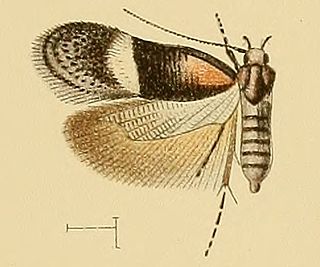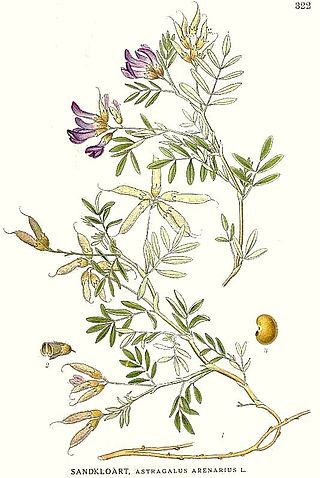
Astragalus is a large genus of over 3,000 species of herbs and small shrubs, belonging to the legume family Fabaceae and the subfamily Faboideae. It is the largest genus of plants in terms of described species. The genus is native to temperate regions of the Northern Hemisphere. Common names include milkvetch, locoweed and goat's-thorn. Some pale-flowered vetches are similar in appearance, but they are more vine-like than Astragalus.

Syncopacma is a genus of moths in the family Gelechiidae.

Syncopacma larseniella is a moth of the family Gelechiidae. It is found in most of Europe.

Elachista albifrontella is a moth of the family Elachistidae found in Europe.

Syncopacma coronillella is a moth of the family Gelechiidae. It is found in most of Europe, except Ireland, Great Britain, Fennoscandia, the Baltic region, the Benelux, Portugal and part of the Balkan Peninsula.

Euzophera fuliginosella is a species of snout moth in the genus Euzophera. It was described by Hermann von Heinemann in 1865. It is found in most of Europe, except Great Britain, Ireland, Norway and the western part of the Balkan Peninsula.

Syncopacma genistae is a moth of the family Gelechiidae. It is found on the Canary Islands.

Syncopacma thaumalea is a moth of the family Gelechiidae. It is found on the Canary Islands and in North Africa.
Syncopacma polychromella is a moth of the family Gelechiidae, it was described by Hans Rebel in 1902.

Anacampsinae is a subfamily of moths in the family Gelechiidae.
Ephysteris insulella is a moth in the family Gelechiidae. It was described by Hermann von Heinemann in 1870. It is found in France, Germany, Switzerland, Italy, Bulgaria, Romania and Russia. Outside of Europe, it is found in south-eastern Kazakhstan, southern Siberia, Mongolia and China.
Syncopacma captivella is a moth of the family Gelechiidae. It was described by Gottlieb August Wilhelm Herrich-Schäffer in 1854. It is found in Portugal, Spain, France, Belgium, the Netherlands, Switzerland, Germany, Italy, Hungary, Poland, the Czech Republic, Croatia and Romania.
Syncopacma cincticulella is a moth of the family Gelechiidae. It was described by Charles Théophile Bruand d'Uzelle in 1851. It is found in Asia Minor and southern and south-eastern Europe, where it has been recorded from Spain, France, Germany, Austria, Switzerland, Italy, the Czech Republic, Slovakia, Hungary, Romania, Poland, Ukraine and Russia.
Syncopacma linella is a moth of the family Gelechiidae. It was described by Pierre Chrétien in 1904. It is found in France, Austria, Slovakia, Hungary, Romania and Ukraine.
Syncopacma crotolariella is a moth of the family Gelechiidae. It was described by August Busck in 1900. It is found in North America, where it has been recorded from Florida.
Syncopacma nigrella is a moth of the family Gelechiidae. It was described by Vactor Tousey Chambers in 1875. It is found in North America, where it has been recorded from Wyoming, Washington, California, Texas, Utah and Oklahoma.

Aproaerema palpilineella is a moth of the family Gelechiidae. It was described by Vactor Tousey Chambers in 1875. It is found in North America, where it has been recorded from Georgia, Illinois, Indiana, Kansas, Kentucky, Louisiana, Maine, Mississippi, Ohio, Oklahoma, Ontario, Quebec, Tennessee and Texas.

Astragalus arenarius, the sand milk-vetch or sand milkvetch, is a species of milkvetch mostly found in Central and Eastern Europe, with populations in Russia stretching perhaps as far as the Urals, and a few instances in Sweden, Finland, and perhaps Denmark. The center of diversity appears to be in Central Russia. Its chromosome number is 2n = 16.








